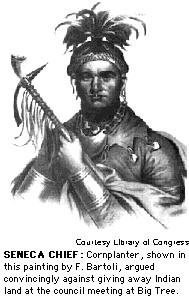
Robert Morris, probably the richest man in America when he financed the Revolutionary War, was an old man in extremely dire straits when he squared off against the Seneca Indians negotiating the infamous Big Tree Treaty.
Morris, who owned all of Western New York at one time, was a signer of the Declaration of Independence, a confidante of George Washington and a very rich man. He gained much of his riches operating privateer boats during the Revolutionary War. Privateers attacked and boarded English merchant ships and confiscated all their cargo.
After the war, he turned to land speculation with an overriding passion and it became his downfall. Historian Henry W. Clune, in his book "The Genesee," said Morris was making his last stand for solvency when the treaty was negotiated in 1797.

Clune wrote, "He was 67 at the time of Big Tree; he had five more years to live, and three of these were to be passed in the Prune Street jail for debtors in Philadelphia." Because of ill health, Robert Morris did not attend the negotiations, but sent his son Tom, who approached the session with great expectations.
The Senecas, likewise, anticipated the council session, but for different reasons. Most were now reluctant to give up any more of their land to the White Man, but converged on the hamlet of Big Tree expecting that "big kettles would be hung" and there would be "a feast of fat things" and much free rum.
Big Tree, now Geneseo, was located on the Genesee River just north of the present Letchworth State Park. The Genesee Valley was the traditional home of the Seneca Nation.
The land transactions of that period were quite complicated. While New York State eventually got sovereignty over state land, Massachusetts claimed title to it. Morris bought all of Western New York from Massachusetts, but the sale was contingent upon gaining title from the Senecas, the true owners.
Morris had struck the deal with Massachusetts, but still needed Indian approval. In the meantime, he sold much of the land to Theophile Cazenove, an agent for the Holland Land Company, but could not get his money until he had cleared the title from the Senecas. He hoped to make enough from the deal to satisfy his creditors.
Hundreds of Indians, many famous Iroquois sachems, or chiefs, attended the meeting and watched Tom Morris start the council fire as negotiations began. Robert Morris had written to his son to ply the Indians with food and gifts, but withhold the whiskey until a treaty was signed.
Tom Morris offered $75,000 for about 4 million acres of land. The Senecas, who had been bested in questionable negotiations by Oliver Phelps and Nathaniel Gorham when they sold most of their land east of the Genesee, were resolved to keep all of their land west of the river.
The negotiations were stalemated. A recess was called, and the next day Morris offered $100,000, but the great Seneca Orator, Red Jacket, said the Indians had already lost much of their traditional land and no amount of money could make them part with any more.
The Seneca Chief Cornplanter asked Morris to check his Bible to see if the White Man's Great Spirit directed them to intrude on Indian property.
Red Jacket, who was noted for his fondness for hard drink, remained a sticking point and the rest of the Senecas listened to his silver-tongued oratory against any land giveaway.
| Niagara Falls Reporter | www.niagarafallsreporter.com | March 25 2003 |